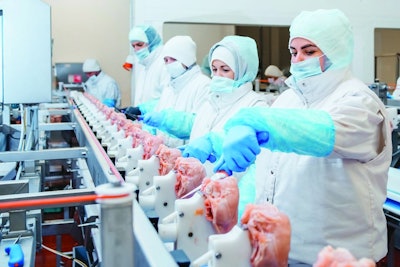
A human-centric approach can help to bring about the best in poultry processing plant employees, to the benefit of the plant. To achieve this, Gary Hamel and Michele Zanini, in their book "Humanocracy," argue that there are a number of changes that any business can implement to achieve this.
Removing bureaucracy, that too often stops organizations and employees from realizing their full potential, is a first step to making companies more human-focused. This can be achieved through adopting simplified management, i.e. adopting a structure that simply comprises directors at one level and operational or frontline employees at the other.
Once the decision has been made to adopt this approach, company directors transfer the management of the company to operations, granting a high level of autonomy, once necessary training has been completed. This change will stimulate the growth of the group of employees, who must understand all aspects of the materials that they work with.
Benefitting from the fact that people are generally resilient, inventive and enthusiastic, companies can be formed that gain from the following characteristics:
- A proactive culture, which is not hiding behind negotiations,
- And an interest in the future. New opportunities are researched, pressing and underlying issues are identified, and employees are encouraged to look for solutions that are simple, economical, quick to implement and that bring amazing results.
Numerous companies in various sectors are already working in this way.
Creativity
Companies need to create a culture that motivates employees to think differently and to innovate, to reduce expenditure and raise productivity.
This approach can help to resolve critical situations, for example a decline in sales, a lack of raw materials or when geopolitical situations may lead to business disruption. In any of these situations, staff may go to visit clients to learn whether upcoming needs may not have been communicated or to learn of underlying needs that may not have been expressed.
Within pre-slaughter and processing there are numerous opportunities to raise bird quality and yield, for example, or to improve working conditions and workplace safety.
An approach to fostering this could be to develop programs that encourage reporting on, and evaluating, aspects of operations, with an aim to increase profitability. In return for doing this, the company rewards those taking part when the outcomes are successful.
Competence
New hires should bring experience and, to help ensure this, front line employees should take part in the selection process. This can help to ensure that new employees will integrate well into the teams where they will work.
New employees must be trained and given a basic knowledge of a broad range of activities within the plant and a deeper understanding of certain specifics. They must be encouraged to consider various, unrelated functions and activities within the plant to see how one may be impacting another.
Detailed development plans must be drawn up, along with professional goals that need to be achieved over set periods. Employees must be constantly aware of the results that the processing plant needs to achieve.
Collaboration
Creating social networks will allow all frontline personnel to be connected, strengthening the bond between them. These networks can be used to share management information and to encourage evaluation of how well daily tasks are performed.
It is easy to create communication networks between production, processing and sales. Keeping the latter informed is particularly important as they will need to be sure that enough birds are being processed to fulfill orders.
Depending on the level of trust that may exist between companies, they may choose to exchange information on how they have handled critical situations or warn of others that are upcoming.
More extensive networks between all companies in a region can be created and used to evaluate operational performance.
Commitment and courage
For there to be real commitment there must be an atmosphere of trust, and trust can be built through ensuring justice, honesty and loyalty.
Creating high levels of trust within and between work groups will help to ensure that teams become effective.
Interpersonal relationships have become ever more important in the business world, and good working relationships are characterized by respect, admiration, understanding and encouragement. When workplace relationships are good, employees feel confident enough to express concerns and ideas which should benefit the organization to which they belong.

















